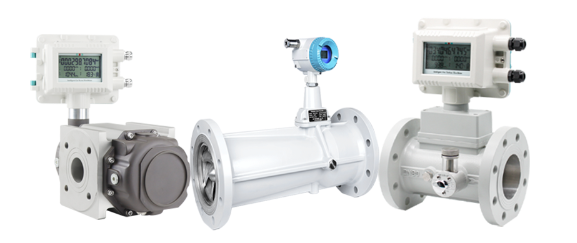Natural Gas Flow Meter
2024-06-24
When measuring natural gas, you can choose a variety of flow meters, each flowmeter has its own specific application scenarios and advantages and disadvantages. The following are several common natural gas flowmeters and their characteristics:
Differential pressure flow meter:
It mainly includes orifice flowmeter, Venturi flowmeter, Annubar flow meter and so on.
Orifice flowmeter is one of the most mature and commonly used methods in natural gas measurement, but the accuracy is relatively low, usually between ±2% and ±5%, the range is relatively small, and the length of the upstream and downstream straight pipe section is higher.
Annubar flowmeter can be used for large diameter natural gas measurement, low pressure loss, but expensive.
Positive displacement flow meter:
It mainly includes Gas Roots Flowmeter, double rotor flowmeter and so on.
High accuracy, usually up to ±0.5% to ±1%, maximum, downstream straight pipe length requirements, suitable for small caliber, small flow of natural gas measurement.
Velocity flow meter:
It mainly includes Gas Turbine Flow Meter, Precession Vortex Flow Meter, Ultrasonic Flow Meter and so on.
Turbine flowmeter has simple structure, high reliability, high accuracy and range, usually between ±0.5% and ±1.5%, but it has requirements for the flow rate and the length of the upper and lower straight pipe sections.
Ultrasonic flowmeters are not affected by gas pressure, temperature, and component changes, with high measurement accuracy and a large measurement range (up to 100:1), but they are expensive, usually with an accuracy of ±0.5% to ±1%.
Mass flow meter:
High, downstream straight pipe section requirements, and high accuracy, good stability, suitable for small caliber, small flow of natural gas measurement. Accuracy is usually between ±0.5% and ±1%.
Sum up:
The selection of natural gas flow timing needs to be comprehensively considered according to the actual measurement needs, economic conditions, installation conditions and environmental conditions. For example, for large diameter, large flow of natural gas measurement, you can choose differential pressure flowmeter or ultrasonic flowmeter; For small diameter, small flow of natural gas measurement, you can choose a positive displacement flowmeter or mass flowmeter. At the same time, it is also necessary to consider the accuracy, repeatability, linearity and other performance indicators of the flow meter to ensure the accuracy and reliability of the measurement results.
If you want to know more about the flow meter or flow meter selection, please consult the Aister flow meter manufacturer email: sales@aistermeter.com for help.
It mainly includes orifice flowmeter, Venturi flowmeter, Annubar flow meter and so on.
Orifice flowmeter is one of the most mature and commonly used methods in natural gas measurement, but the accuracy is relatively low, usually between ±2% and ±5%, the range is relatively small, and the length of the upstream and downstream straight pipe section is higher.
Annubar flowmeter can be used for large diameter natural gas measurement, low pressure loss, but expensive.
Positive displacement flow meter:
It mainly includes Gas Roots Flowmeter, double rotor flowmeter and so on.
High accuracy, usually up to ±0.5% to ±1%, maximum, downstream straight pipe length requirements, suitable for small caliber, small flow of natural gas measurement.
Velocity flow meter:
It mainly includes Gas Turbine Flow Meter, Precession Vortex Flow Meter, Ultrasonic Flow Meter and so on.
Turbine flowmeter has simple structure, high reliability, high accuracy and range, usually between ±0.5% and ±1.5%, but it has requirements for the flow rate and the length of the upper and lower straight pipe sections.
Ultrasonic flowmeters are not affected by gas pressure, temperature, and component changes, with high measurement accuracy and a large measurement range (up to 100:1), but they are expensive, usually with an accuracy of ±0.5% to ±1%.
Mass flow meter:
High, downstream straight pipe section requirements, and high accuracy, good stability, suitable for small caliber, small flow of natural gas measurement. Accuracy is usually between ±0.5% and ±1%.
Sum up:
The selection of natural gas flow timing needs to be comprehensively considered according to the actual measurement needs, economic conditions, installation conditions and environmental conditions. For example, for large diameter, large flow of natural gas measurement, you can choose differential pressure flowmeter or ultrasonic flowmeter; For small diameter, small flow of natural gas measurement, you can choose a positive displacement flowmeter or mass flowmeter. At the same time, it is also necessary to consider the accuracy, repeatability, linearity and other performance indicators of the flow meter to ensure the accuracy and reliability of the measurement results.
If you want to know more about the flow meter or flow meter selection, please consult the Aister flow meter manufacturer email: sales@aistermeter.com for help.
Share To:
Previous Post:
News
- Why is the thermal gas mass flowmeter not affected by pressure strength and temperature?
- What to do when a thermal gas mass flow meter fails?
- How are thermal gas mass flow meters used? What are the applications?
- Under what circumstances is the gas measurement need to be regulated compensated vortex flowmeter
- Why Is The Aister Thermal Gas Mass Flowmeter So Popular ?
- Gas turbine flowmeter manufacturers explain their main advantages in measurement
- Gas turbine flowmeter manufacturer Aister instrument field experience summary
- Aister Instrument Empowerment Conference









